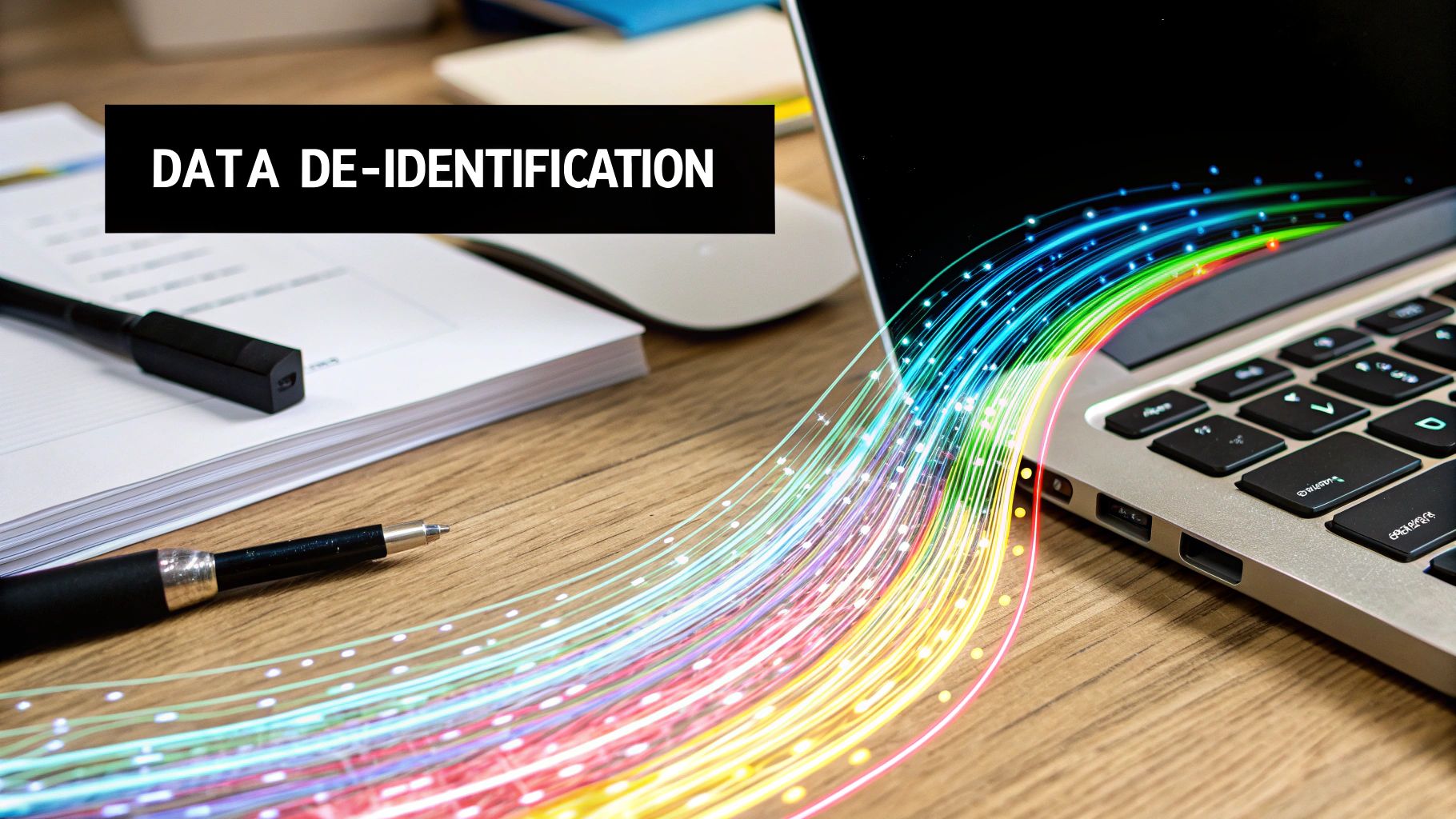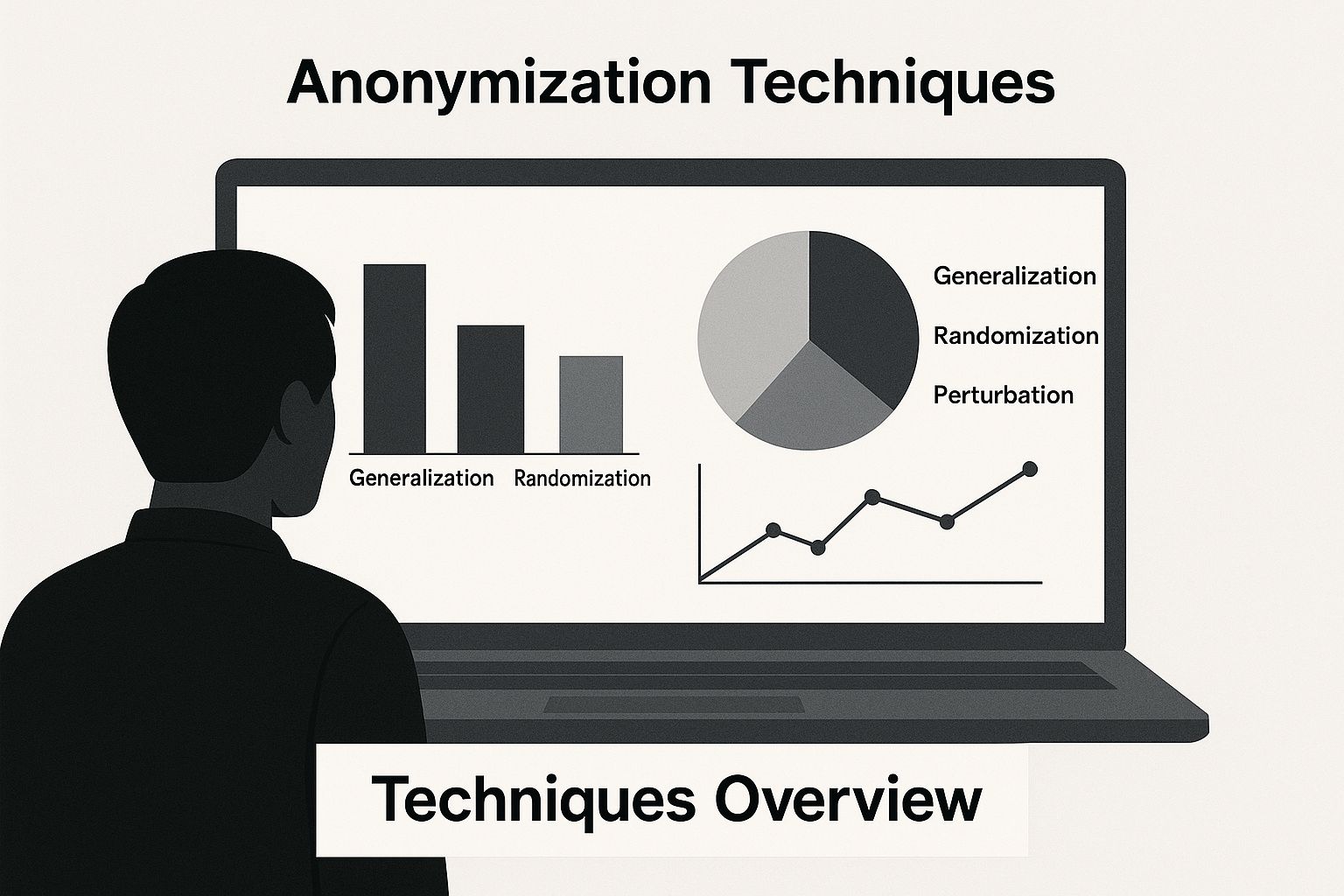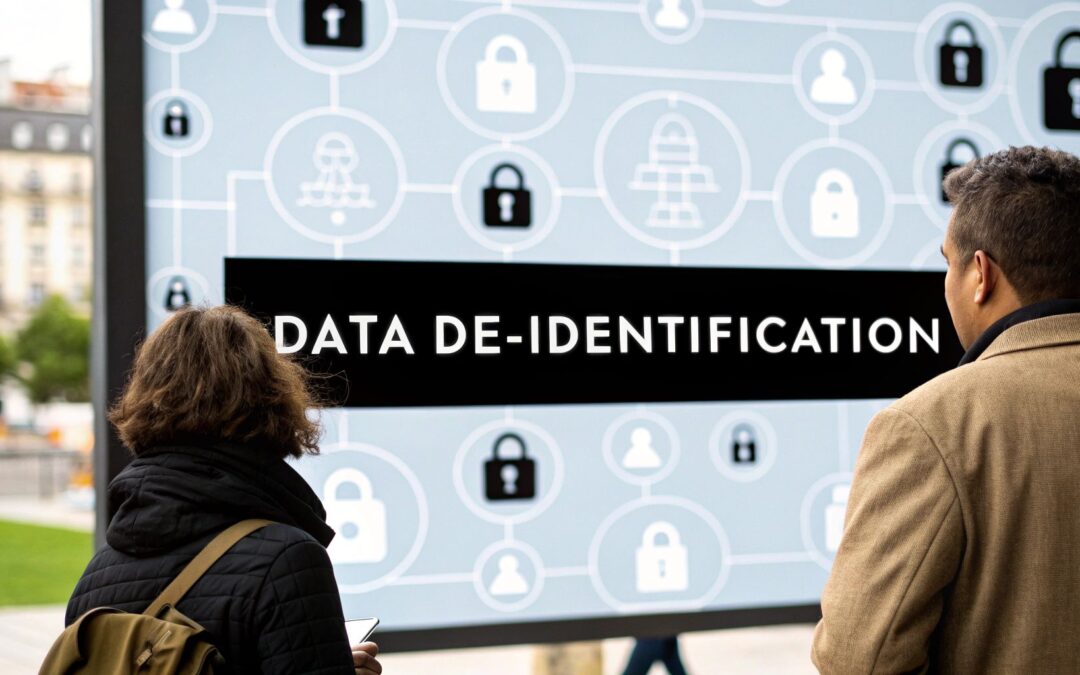At its core, data de-identification is the process of stripping away or scrambling personal details from a dataset so you can’t link the information back to a specific person. It's a fundamental privacy-enhancing technique that opens the door for organizations to safely use data for crucial tasks like research, analytics, and software development.
Unlocking Data Value While Protecting Privacy

Think of it like editing a documentary where you need to protect your subjects' identities. You might blur their faces, alter their voices, or cut out any mention of their names and hometowns. The story remains just as powerful, but the individuals are now anonymous. That's a great analogy for what data de-identification does for information.
This process is much more sophisticated than just deleting a column of names from a spreadsheet. It’s about methodically removing or transforming any piece of data that could, either on its own or in combination with other data, point back to a person.
This allows organizations to dig into valuable trends and patterns without putting personal privacy at risk. The goal is to find that sweet spot—protecting people while still enabling the data-driven insights that fuel progress. Of course, this technique is just one part of a comprehensive data security strategy.
What Information Gets Removed?
De-identification focuses on two main types of information. The first is direct identifiers, which are the obvious culprits that explicitly name a person. The second, and often trickier, category is indirect identifiers (sometimes called quasi-identifiers), which can be pieced together like a puzzle to single someone out.
Imagine working with a healthcare dataset. The direct identifiers like names and patient IDs are easy to spot. But the indirect ones are just as sensitive. A combination of a rare medical diagnosis, a small-town zip code, and a specific date of hospital admission could quickly reveal a patient's identity, even without a name attached.
De-identification is fundamentally an exercise in risk management, not complete risk elimination. The goal is to make re-identification so difficult and impractical that the privacy risk becomes incredibly low.
To be truly effective, the process must anticipate and address all potential ways someone might try to re-identify individuals. The following table breaks down the kinds of Personally Identifiable Information (PII) typically removed or altered in this process.
Common Personal Identifiers Removed During De-Identification
This table summarizes the types of Personally Identifiable Information (PII) that are commonly removed or altered to protect individual privacy.
| Identifier Category | Example Data Points |
|---|---|
| Direct Identifiers | Names, Social Security Numbers, Email Addresses, Phone Numbers, Full Street Addresses |
| Demographic Data | Full Date of Birth, Specific Age (if over 89), Precise Geographic Subdivisions (like zip codes) |
| Biometric Identifiers | Fingerprints, Retinal Scans, Full Face Photographic Images |
| Unique Numbers & Codes | Medical Record Numbers, Health Plan Beneficiary Numbers, Account Numbers, Vehicle Identifiers |
| Web & Device Data | IP Addresses, Device Serial Numbers, Uniform Resource Locators (URLs) |
By tackling these identifiers, organizations can significantly reduce the risk of privacy breaches while still drawing meaningful conclusions from their data.
Why De-Identification Is a Business Imperative
In a world where data is currency, de-identification has moved from a back-office IT task to a front-and-center business strategy. The reasons are clear, touching everything from your bottom line and brand reputation to your ability to stay ahead of the competition. It's really about getting ahead of risk in an environment where your data is both a massive asset and a serious liability.
Let's be blunt: failing to protect personal data can be financially devastating. Regulations like GDPR and HIPAA come with steep penalties, sometimes reaching millions of dollars, which can easily cripple a business. But the fallout from a data breach often cuts much deeper than just the initial fine.
Building Trust Through Privacy
The most lasting damage from a privacy failure is the loss of customer trust. People are savvier than ever about how their personal information is being used. They’re making conscious choices to do business with companies that prove they genuinely care about protecting privacy.
When you implement solid data de-identification, you're sending a powerful message. You're telling your customers you respect their privacy and can be trusted with their information. This isn't just about checking a compliance box; it's about building a stronger, more loyal customer base.
This mindset flips the script, turning de-identification from a defensive chore into a proactive way to stand out. Companies that put privacy first are seen as ethical leaders, and that’s a powerful position in today's market.
Enabling Innovation Safely
Beyond just managing risk, de-identification is what allows you to move forward. It unlocks the incredible value tucked away in your datasets, letting you run powerful analyses without putting anyone's privacy on the line.
Think about it—AI and machine learning models need enormous amounts of data to learn effectively. De-identified data provides the fuel for this kind of innovation, especially for startups trying to build incredible systems responsibly. You can explore more on how quality data preparation is essential in our guide on why data annotation is critical for AI startups in 2025.
The market growth tells the same story. The global Data De-identification Software Market was valued at around USD 1.5 billion in 2024 and is expected to hit USD 5.2 billion by 2033. What's driving this? A recent report found that nearly 60% of companies point to regulatory compliance as their main reason for investing in privacy tech, proving it’s a core strategic concern. You can discover more insights about this trend and the growth of the de-identification market.
Ultimately, understanding the full scope of regulations is vital for any organization that handles sensitive information. This makes de-identification a cornerstone of your overall data security compliance strategy. Weaving de-identification into your daily operations isn't just an expense—it's an investment in sustainable growth, customer loyalty, and the long-term health of your business.
Core Techniques for De-Identifying Your Data
So, how do you actually de-identify data? It’s not a one-size-fits-all process. Think of it less like a single button and more like a skilled craftsperson's toolkit. You have a collection of different tools, and the right one depends entirely on the job at hand—balancing the absolute need for privacy with the practical need for useful data.
The most common methods range from simply blacking out information to applying sophisticated statistical changes. Getting a handle on these core techniques is your first real step toward building a de-identification strategy that’s both responsible and effective.
The image below gives you a great visual of how these techniques take raw, sensitive data and transform it.

As you can see, the goal is to break the link between the data and a specific person, all while keeping the dataset valuable for analysis. Let's dig into the most common ways this is done.
Foundational Methods of De-Identification
Two of the most common and direct techniques you'll come across are suppression and masking. They’re often the starting point for many de-identification projects because they're straightforward and get right to the point of handling obvious personal details.
Suppression is exactly what it sounds like: you completely remove certain data. If a column in your dataset contains something highly sensitive like Social Security Numbers, suppression just deletes that entire column. It's incredibly effective at removing direct identifiers, but there's a clear trade-off. You lose that data forever, which can limit what kind of analysis you can do later.
Data Masking is a bit more subtle. Instead of just deleting the data, you replace sensitive information with realistic-looking but fake data. For example, the name "Jane Doe" might become "Sarah Miller." This keeps the dataset's structure and format intact, making it perfect for things like software testing, where you need data that looks and feels real.
You see data masking all the time when a website shows only the last four digits of your credit card, like XXXX-XXXX-XXXX-1234. The critical information is hidden, but the format is preserved.
Advanced and Structural Techniques
Once you move past the obvious identifiers, you need more advanced methods that alter the very structure of the data to prevent re-identification. These are critical when dealing with complex datasets full of indirect identifiers that could be pieced together.
Pseudonymization: This is like giving everyone in your dataset a secret codename. You swap out a direct identifier, like a patient's name or customer ID, for a consistent but fake one (the "pseudonym"). This lets you track an individual's activity across the dataset without ever knowing who they really are. A critical feature is that a trusted, authorized party can hold the "key" to re-link the data if needed, making it invaluable for long-term studies.
Other key structural methods include:
- Generalization: This technique dials back the precision of the data. For instance, instead of listing someone's exact age as "37," you would generalize it into an age range like "35-40." A specific zip code could be broadened to just the city or state.
- Noise Addition: This method involves adding small, random statistical variations to the numbers in your dataset. It slightly skews the individual data points to protect privacy but ensures the overall dataset remains statistically accurate for big-picture analysis.
- Swapping: Also known as permutation, this involves shuffling the values of certain attributes among different records. Imagine you have a dataset with users and their locations. Swapping would randomly exchange the locations among several users, breaking the direct link between a person and their specific location while keeping the overall distribution of locations in the data intact.
Comparing Data De-Identification Techniques
Choosing the right technique is a balancing act. You're constantly weighing how much you need to protect the data against how useful it needs to be. Some methods are great for quick, simple tasks, while others are built for complex analytical needs where preserving statistical accuracy is paramount.
The table below breaks down these common methods, comparing them based on their best use case, how much they impact the data's usefulness (utility), and the lingering risk of someone being re-identified.
| Technique | Primary Use Case | Data Utility | Re-Identification Risk |
|---|---|---|---|
| Suppression | Removing direct identifiers (SSNs, names). | Low (data is lost) | Very Low |
| Data Masking | Creating realistic test/dev data. | Medium (format preserved) | Low |
| Pseudonymization | Longitudinal studies, tracking over time. | High (data is linkable) | Moderate (depends on key security) |
| Generalization | Releasing public summary data. | Medium (precision is lost) | Low |
| Noise Addition | Large-scale statistical analysis. | High (statistically accurate) | Low |
| Swapping | Preserving attribute distribution. | Medium-High (relationships altered) | Low |
Ultimately, there's no single "best" technique. In fact, many robust de-identification strategies use a combination of these methods—a layered approach that provides strong protection while keeping the data valuable for its intended purpose.
Putting De-Identified Data to Work: Real-World Innovation
The techniques for de-identifying data are clever, but the real magic happens when you see what this process unlocks in the real world. This is where the theory hits the road, turning sensitive information into a powerful—and safe—resource for progress across major industries. It’s the key to making smarter, evidence-based choices, which is the heart of effective data-driven decision making.
Nowhere is this more apparent than in healthcare. De-identified patient data is the lifeblood of modern medical research. It allows scientists to get a bird's-eye view of diseases, monitor public health crises, and test how well new treatments work across huge populations—all without risking a single person's privacy.
Think about researchers studying the long-term effects of a new heart medication. By looking at thousands of de-identified health records, they can connect the dots and spot subtle patterns that would be invisible in a small study. This leads directly to safer drugs and smarter public health policies.
This critical role in healthcare is fueling a booming market. In 2024, the global de-identified health data market was valued at USD 8.09 billion, and it's expected to jump to USD 13.59 billion by 2030. This growth is driven by the need for massive, privacy-compliant datasets to power analytics under regulations like HIPAA.
Beyond the Hospital Walls
While healthcare often grabs the headlines, the benefits of de-identification reach into nearly every corner of our data-driven world. Different industries are using it to solve their own unique problems, boosting both security and innovation.
1. Financial Services and Fraud Detection
Banks and credit card companies are sitting on a treasure trove of transaction data. By stripping out personal details, they can feed this information into advanced AI models to learn what normal spending looks like. When a transaction deviates from the pattern—like a sudden, large purchase in another country—the system flags it as potential fraud, protecting customers in real-time.
2. Retail and Understanding Shoppers
Ever wonder how a grocery store knows exactly where to place the milk? It's often thanks to de-identified data. Retailers analyze purchase histories to see what people buy, when they buy it, and what they buy together. These insights help them optimize store layouts, keep popular items in stock, and spot the next big trend, all while respecting shopper privacy.
3. Urban Planning and Building Smarter Cities
City planners use de-identified location data from mobile phones and public transit cards to map the pulse of a city. They can see traffic bottlenecks, understand how people move between neighborhoods, and figure out the best spots for a new bus route or bike lane. This helps create cities that are more efficient and enjoyable for everyone. We even see this in advanced tools like healthcare virtual assistants, which rely on vast, anonymized information to function effectively while upholding strict privacy standards.
Navigating The Challenges and Best Practices
While data de-identification is a powerful tool, it’s not a magic wand that instantly eliminates all privacy risks. To get it right, you need to be realistic about the challenges and commit to a set of proven best practices.

The biggest hurdle, by far, is the lingering risk of re-identification. A determined person could potentially piece together anonymized information—often by cross-referencing it with other public datasets—to figure out who someone is.
Think of it like this: a de-identified dataset is like a blurry photograph. If it’s too blurry, the photo is useless. If it's not blurry enough, you can still recognize the face. The core challenge is striking that perfect balance between protecting privacy and keeping the data useful. This is where a solid strategy comes into play.
Establishing a Strong De-Identification Framework
A truly successful de-identification program isn't about picking one technique and hoping for the best. It's about building a multi-layered defense with a structured approach that makes your efforts both effective and responsible right from the start.
The goal isn’t to achieve absolute, unbreakable anonymization—which is often impossible without destroying the data’s value. Instead, the objective is to reduce the re-identification risk to a very small, manageable, and acceptable level.
Here are some essential best practices to get you there:
-
Conduct a Risk Assessment: Before you do anything else, you need to understand your data. Identify all direct and indirect identifiers, figure out how sensitive the information is, and think carefully about who will use the de-identified set.
-
Choose Appropriate Techniques: There's no one-size-fits-all solution. You should select a combination of methods—like suppression, generalization, and pseudonymization—based on what your risk assessment tells you and how you plan to use the data.
-
Implement a 'Defense-in-Depth' Strategy: Think in layers. The de-identification process is just one control. You also need strong access controls, clear data use agreements, and continuous security monitoring to protect the data at every stage.
-
Follow Established Standards: Don't reinvent the wheel. Stick to recognized frameworks like the HIPAA Safe Harbor method or the Expert Determination method. These provide clear, defensible guidelines that help you meet strict regulatory demands.
The growing need for these robust practices is clear in market trends. In 2023, the global market for de-identification software hit USD 2.4 billion and is expected to climb to USD 14.5 billion by 2033. You can see a full breakdown of this growth in the data de-identification software market report.
By implementing these best practices, you not only protect privacy but also improve efficiency—a key principle in modern business process automation.
Answering Your Questions About Data De-Identification
As data privacy becomes a bigger part of our daily conversations, it's natural to have questions about how de-identification actually works in practice. Let's tackle some of the most common ones to clear things up.
Is De-identification the Same as Anonymization?
It’s a common point of confusion, but they aren't quite the same thing. People often use the terms interchangeably, but there’s a subtle yet important difference.
Think of it this way: anonymization is the ultimate goal—a state where data can never be traced back to an individual. De-identification is the process you use to get there. It’s the collection of techniques, like masking or generalization, that you apply to the data.
A perfect example of this is pseudonymization. This technique swaps out direct identifiers (like a name) for a consistent but random value (a "pseudonym"). The data is now de-identified, but because someone with the right key could reverse the process, it isn't fully anonymous.
Can De-identified Data Ever Be Re-identified?
In short, yes. There's always some lingering risk of re-identification. This is especially true if the de-identification wasn't thorough enough or if a bad actor gets their hands on another dataset they can use to connect the dots.
The hard truth is that no single method is 100% foolproof. That’s precisely why a defense-in-depth strategy is critical. You have to layer techniques like k-anonymity and differential privacy and constantly assess the risk.
The real aim is to make re-identifying someone so incredibly difficult, time-consuming, and expensive that the risk becomes negligible.
Does De-identification Satisfy GDPR and HIPAA Requirements?
It can, but you have to do it right. Both GDPR and HIPAA have very specific standards for what counts as properly de-identified data. Under GDPR, for instance, once data is effectively de-identified, it's no longer considered "personal data" and is exempt from many of the regulation's tightest restrictions.
Similarly, HIPAA has two official methods—the Safe Harbor method and the Expert Determination method. If you follow one of these paths correctly, your data is no longer classified as Protected Health Information (PHI). But let's be clear: you must meet their strict criteria. Just stripping out a few names and addresses won't cut it.
At Zilo AI, we know how tricky it can be to navigate the world of sensitive information. Our expert data annotation and manpower services are designed with privacy and security built-in from the ground up, making sure your projects are both compliant and effective. To see how we can help with your data challenges, come find us at https://ziloservices.com.

